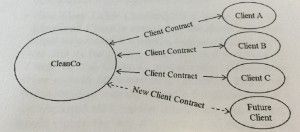National Labor Relations Board's decision in Browning-Ferris Industries of California, Inc., 362 NLRB No. 186 (Aug. 27, 2015), will have significant and far-reaching effects as it greatly expands the scope of relationships in which the Board can and will find entities to be joint employers. While the full ramifications of the Board's decision remain to be seen, here are five issues, which are discussed thoroughly by Members Miscimarra and Johnson in their dissent, that employers will likely face as a result of Browning-Ferris:
1. No Certainty or Guidance On When a Joint Employer Relationship is Formed
Under the Board's new standard where "all of the incidents of the [business] relationship must be assessed," it is impossible to predict how the Board will weigh and factor those facts in deciding whether a joint-employer relationship exists. As noted by the dissent, the new test gives the Board the discretion to "give dispositive weight to an employer's control over any essential term and condition of employment in finding a joint-employer relationship."
Our colleagues presumably do not intend that every business relationship necessarily entails the joint employment of every entity's employees, but there is no limiting principle in their open-ended multifactor standard. It is an analytical grab bag from which any scrap of evidence regarding indirect control or incidental collaboration as to any aspect of work may suffice to prove that multiple entities–whether they number two or two dozen–"share or codetermine essential terms and conditions of employment."
Now, the only guidepost employers have consists of the specific facts in Browning-Ferris, where the Board found a joint-employer relationship existed. The "sum total" of evidence supporting the Board's joint employer conclusion was:
- a few contract provisions that indirectly affect the otherwise unfettered right of the supplier-employer to hire its own employees;
- reports by the user-employer's representatives to the supplier-employer of two incidents–one where an employee was observed passing a "pint of whiskey" at the jobsite, and another where an employee "destroyed" a drop box;
- one contractually-established pay rate ceiling restriction for the supplier-employees stemming from the cost-plus nature of the contract;
- the user-employer's control of its own facility's hours and production lines;
- a record-keeping requirement for the supplier-employer's employee hours stemming from the cost-plus nature of the contract;
- a sole preshift meeting to advice the supplier-employer supervisors of what liens will be running and what tasks they are supposed to do on those lines;
- monitoring of productivity;
- establishment of one type of generally applicable production assignment scheme for the supplier-employer; and
- "on occasion," addressing supplier-employer employees about productivity directly.
However, the Board's decision does not specify which facts were controlling or determinative in its analysis, rather it embraced a vauge totality of the circumstances approach. As the dissent warns, such a test "can become simply a cloak for agency whim–or worse." Until such time as the Board offers more definitive guidance (if it ever does) as to what should be determinative, employers must operate under the assumption that the Board's new joint-employer standard will simply be that the 'Board will know it when it wants to see it.'
2. Unstable Bargaining Relationships
The dissent aptly notes that the Board's new joint-employer standard has the potential to "produce bargaining relationships and problems unlike any that have existed in the Board's entire-80-year history, which clearly were never contemplated or intended by Congress." By way of example, the dissent pondered how bargaining would work when there are multiple clients who are joint employers with a cleaning company that provides cleaning services at each of the client's facilities:

The dissent's example exposes a myriad of issues and problems created by the Board's new test. For example, what are the bargaining units if a union seeks to organize CleanCo's employees–is it a single unit or must there be separate units based on what clients the employees serve (and what happens if the employees serve multiple, but not all of the clients)? Because joint employers only have to bargain over terms and conditions for which they possess the authority to control, how is determined who who controls what terms? Also, will employers now be required to engage in segmented bargaining, a practice traditionally denounced by the Board? What happens when the joint employers disagree during bargaining? Will CleanCo be required to disclose to Client A how much it is charging Clients B and C (and do the same for the other clients)? How many labor contracts will ClientCo have to enter and what are their duration?
Another issue exposed by the dissent in this scenario is the possibility of non-consensual multiemployer bargaining. Under current Board law, bargaining units consisting of both jointly employed temporary workers and regular workers employed solely by the user employer constitute multiemployer units, which require the consent of both employers. Consequently, the question remains whether Browning-Ferris overruled the Board's prohibition on non-consensual multiemployer bargaining, but given the Board's invitation of briefs in Miller & Anderson, this question will not go unanswered for long.
3. Loss of Protections from Secondary Economic Coercion
The expansion of the joint-employer doctrine will make more entities primary employers, and thus expose them to labor disputes that are not directly their own. As a result, those entities will no longer receive the protections of 8(b)(4) and (e) of the National Labor Relations Act, which protect neutral parties from being subjected to "secondary" picketing and other threats, coercion and restraint that have an object of forcing one employer to cease doing business with the other. Using the CleanCo example, if CleanCo's clients are not joint employers with it, CleanCo's employees servicing Client A could not picket or boycott Client A as part of their labor dispute with CleanCo. However, if Client A is a joint employer with CleanCo under the new standard, then Client A would be subject to a boycott and picketing by CleanCo's employees. According to the dissent:
[t]his limits the Act's secondary-boycott prohibitions in a manner Congress did not intend. The targeted joint employer may not have direct control or even any control over the particular terms and conditions of employment that are the genesis of the labor dispute. Here, the economic consequences are far reaching. For example, a union could picket all of the user employer's facilities even though the supplier employer only provides services at one.
4. Limited Ability to Replace Unionzed Contractors
First, an entity is generally free under the National Labor Relations Act to terminate a contractor if it becomes unionized. However, if that entity is deemed to be a joint employer with the contractor, it can no longer do so without violating the Act.
Second, Browning-Ferris will limit the application of the Board's successorship principles, thus hindering an entity's ability to replace an inefficient or expensive contractor. It is well established that successor employers are not obligated to adopt a pre-existing collective bargaining agreement and have the right to unilaterally set different initial terms and conditions of employment. However:
[u]nder the majority's expansive joint-employer standard, many user employers will now be considered joint employers of their supplier employers' employees. Rebidding contracts has been a common feature of the user–and supplier–employer market. Going forward, it may be less common because deeming the user employer to be a joint employer will make terminating or rebidding the contract with the supplier employer much more difficult. The user employer will often have a duty to bargain the decision to lay off the employees or to subcontract those jobs to another supplier employer.... Assuming the user employer does contract with a new supplier employer that would otherwise be a Burns successor able to set its own terms, the user employer, under the broadened standard, will likely be deemed a joint employer with the new supplier as well. That user employer's ongoing bargaining obligation spanning the two supplier employers prevents the new supplier employer from setting different terms and conditions of employment than its predecessor had.
5. Franchising and Parent-Subsiary Relationship Are Threatened
Historically, the Board has generally not held franchisors to be joint employers with franchisees, regardless of the degree of indirect control retained, but the Board majority in Browning-Ferris failed to address what impact, if any, its decision has on franchising. As observed by the dissent:
we are left to ponder whether the majority even agrees with the statement of the General Counsel in his amicus brief that "[t]he Board should continue to exempt franchisors from joint employer status to the extent their indirect control over employee working conditions is related to their legitimate interest in protecting the quality of their product or brand...." Given the breadth of the majority's test and rationale, we are concerned that the majority effectively finds that a franchisor even with this type of indirect control. would be deemed a joint employer.
Of equal concern is that Browning-Ferris "threatens to automatically sweep every parent or affiliate company in America into being the 'employer' of a subsidiary's employees, with the concomitant bargaining obligations, the loss of secondary-employer protection from union strikes..., and all the other deleterious results mentioned above."
The content of this article is intended to provide a general guide to the subject matter. Specialist advice should be sought about your specific circumstances.


